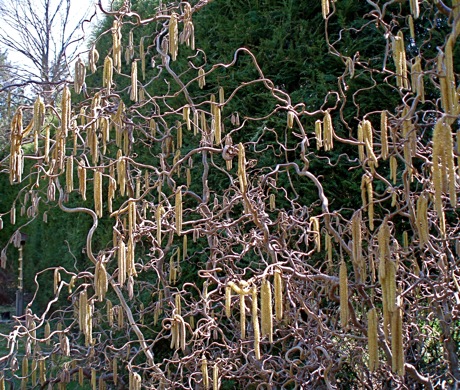Eric’s Pet Plant: Black Pussywillow (Salix gracilistylus ‘Melanostachys’)
As you may be noticing long about now, we are surrounded by spring flowers, their heart-lifting color everywhere – in the landscape, on garden blogs, at nurseries, in omigodheretheycome fall bulb catalogs.
But there’s one branch of the spring flower shower that doesn’t get as much notice as it deserves, the one that doesn’t have any petals (At least not petals the way forsythia has petals, and certainly not the way daffodils have petals).
So right here I want to put in a good word for catkins, the fuzzy flowering parts of birches, beeches, mulberries, hazels and of course pussy willows.
In a moment, our friend Eric will be extolling the Black Pussy Willows he grows over at Yale, but first a glimpse of our own backyard thrill, the contorted hazel, in full chandelier mode:
The stems look a lot like the curly branches offered at some high end florists, but those are usually the faster growing curly willow, which brings us back to Eric and his fashionably
Black Pussy Willow (Salix gracilistylus ‘Melanostachys’)
By Eric Larson
My oldest friend, or a better term would be the friend I have known the longest, sent me an e-mail at the end of March with the following as his last line: “I would tell you that the color of green produced by plants waking up from winter never ceases to lift me.”
Couldn’t have said it better myself. If every day is a gift – and if we don’t remember that at least once in a while, we need to check our own pulse for life – then every spring is a stupendous totally encompassing miracle…
not all of which is green. The waking Black Pussy Willow, for instance, is anything but. Yet it too is miraculous, and it puts on its big spring show just as the season begins.

The black catkins last for up to four weeks depending on the weather. Most catkins are wind-pollinated, but willows tend to be associated with early spring insect activity.
Flowers form along the stems of the plant, the procession of dusky catkins resembling little black caterpillars – very closely, if you have a good imagination. There is an anecdote that a customer called a garden hot line with a complaint that there were scores of wooly worms on her willow bush. Egad, hand pick them or you are doomed!
The catkins can range from a half-inch to two inches in length, starting small early in the season, then lengthening and changing color as they mature. Females stay flat black until well-expanded; males will add a fine-textured, silky red to orange staminate haze to the display. (Willows are dioecious, which means that like humans, holly and marijuana, each individual has one gender and it takes two to make progeny.)
Like many of its genus, Black Pussy Willow is a quick growing shrub. It ends up six to ten feet tall, but can be more than ten feet wide because it will spread aggressively by underground adventitious roots and above ground ‘suckers.’
Don’t fret too much; if necessary you can prune this plant pretty severely to keep it in check. I prefer to let it attain its natural size, and then lightly prune it back. The stems tend to be somewhat brittle so can be damaged in windy locations, or by heavy snow load. To avoid broken branches and distorted shapes, it is best to prune it proactively, keeping it relatively compact, no matter what shape and size you prefer.
Although it won’t grow in standing water, this plant, like most willows, loves to have water very nearby. Unfortunately (once more, like most willows) it is subject to rust, leaf spot, canker and other pathogens. Planting in full sun will help keep some of the fungal problems in check.
There is also a list of insects that seem to enjoy feeding on it, but ours doesn’t seem to be too badly munched upon. I think if you have a lot of willows, you are more likely to encounter problems, while with only one or two, you might sneak under the pest radar.
Average garden soil in the slightly acid range is great for this plant, but it’s quite tolerant of other soil types as well as moderate road salt and pollution exposure. I have seen it used in a median strip situation in Delaware to good effect.
Its natural propensity to sucker out into a fairly large clump makes it ideal for holding stream banks, protecting hillside soil and reclaiming wetlands. It could also be used to good effect in the shrub border, as I have here at Marsh Botanical Garden.
The silver-catkined S. caprea is better known, but S. gracilistylus ‘Melanostachys’ is fully its equal for providing great cut flower material and late winter/early spring interest in the garden.
I haven’t seen this plant offered locally – at least not yet. We got ours from Forest Farm.

Our plant does its best to ease the industrial view of electrical transformer and chain link fence. During the summer the gray-green to silver foliage does a pretty good job, while providing a counter-point to the predominantly green landscape around it.
















Thanks for the Black Pussy Willow advice & wisdom. I just bought my first one ever this past Spring, at a local plant sale. It seems that I’ve planted it in an optimal spot; our extensive back yard has a swale in full sun, so there grows our little BPW bush with it’s roots in perpetual moisture (not, fortunately, standing water), here in Zone 5. It has had some rust and spotting over the summer but appears basically healthy and has had some nice shoots; the acursed Japanese Beetles pretty much left it alone. I’m looking forward to it’s “little black caterpillars” next Spring. Glad to read your information.
Indeed there are a few rust problems that bedevil the look of BPW especially late in the growing season, but do not threaten its life. I’m sure you will enjoy the three or four weeks of wonderful catkin display. Eric